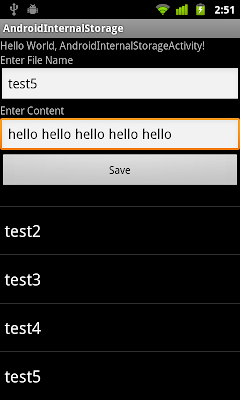It's a example, in ShowSavedFiles() method, get the saved file name and list in ListView.

package com.exercise.AndroidInternalStorage;
import java.io.FileNotFoundException;
import java.io.FileOutputStream;
import java.io.IOException;
import android.app.Activity;
import android.content.Context;
import android.os.Bundle;
import android.view.View;
import android.widget.ArrayAdapter;
import android.widget.Button;
import android.widget.EditText;
import android.widget.ListView;
import android.widget.Toast;
public class AndroidInternalStorageActivity extends Activity {
EditText edFileName, edContent;
Button btnSave;
ListView listSavedFiles;
String[] SavedFiles;
/** Called when the activity is first created. */
@Override
public void onCreate(Bundle savedInstanceState) {
super.onCreate(savedInstanceState);
setContentView(R.layout.main);
edFileName = (EditText)findViewById(R.id.filename);
edContent = (EditText)findViewById(R.id.content);
btnSave = (Button)findViewById(R.id.save);
listSavedFiles = (ListView)findViewById(R.id.list);
ShowSavedFiles();
btnSave.setOnClickListener(new Button.OnClickListener(){
@Override
public void onClick(View arg0) {
// TODO Auto-generated method stub
String fileName = edFileName.getText().toString();
String content = edContent.getText().toString();
FileOutputStream fos;
try {
fos = openFileOutput(fileName, Context.MODE_PRIVATE);
fos.write(content.getBytes());
fos.close();
Toast.makeText(
AndroidInternalStorageActivity.this,
fileName + " saved",
Toast.LENGTH_LONG).show();
} catch (FileNotFoundException e) {
// TODO Auto-generated catch block
e.printStackTrace();
} catch (IOException e) {
// TODO Auto-generated catch block
e.printStackTrace();
}
ShowSavedFiles();
}});
}
void ShowSavedFiles(){
SavedFiles = getApplicationContext().fileList();
ArrayAdapter<String> adapter
= new ArrayAdapter<String>(this,
android.R.layout.simple_list_item_1,
SavedFiles);
listSavedFiles.setAdapter(adapter);
}
}
<?xml version="1.0" encoding="utf-8"?>
<LinearLayout xmlns:android="http://schemas.android.com/apk/res/android"
android:orientation="vertical"
android:layout_width="fill_parent"
android:layout_height="fill_parent"
>
<TextView
android:layout_width="fill_parent"
android:layout_height="wrap_content"
android:text="@string/hello"
/>
<TextView
android:layout_width="fill_parent"
android:layout_height="wrap_content"
android:text="Enter File Name" />
<EditText
android:id="@+id/filename"
android:layout_width="fill_parent"
android:layout_height="wrap_content" />
<TextView
android:layout_width="fill_parent"
android:layout_height="wrap_content"
android:text="Enter Content" />
<EditText
android:id="@+id/content"
android:layout_width="fill_parent"
android:layout_height="wrap_content" />
<Button
android:id="@+id/save"
android:layout_width="fill_parent"
android:layout_height="wrap_content"
android:text="Save"/>
<ListView
android:id="@+id/list"
android:layout_width="fill_parent"
android:layout_height="wrap_content"
/>
</LinearLayout>
next:
- Read file from Internal Storage via FileInputStream
Hi,
ReplyDeleteHow do I download a file directly into the private folder?
Also, how do I access it from there after downloading? Kindly help! Urgent!
How to delete the saved file?
ReplyDeletehello andoy,
ReplyDeletePlease refer Delete file in Internal Storage
Hello.
ReplyDeleteThis tutorial is really exciting. I'm newbie. I have a question. How save 3 or 4 edittext in one list row? fileList() method saved only one fos(FILEOUTPUTSTREAM) file. How solve this problem? please.
Thank you.
In my understand, you can retrieve the text from the various edittext, and add them together to have one String.
ReplyDeleteex.
String result = edittext1.getText().toString + edittext2.getText().toString +
...;
Hello.
ReplyDeleteI put in 2 items and 1 image in internal storage list row so how solve this problem. could u create another example please. it's important to me.
please!!!
how to open the saved files
ReplyDeletehello Hanisha Sachdeva,
ReplyDeleteRefer to the next post Read file from Internal Storage via FileInputStream.